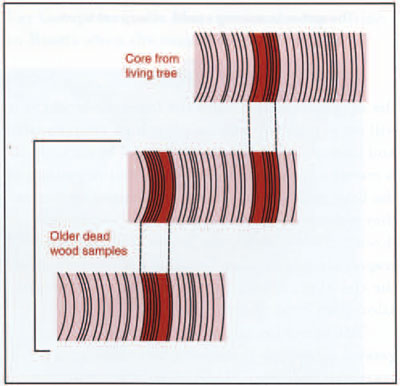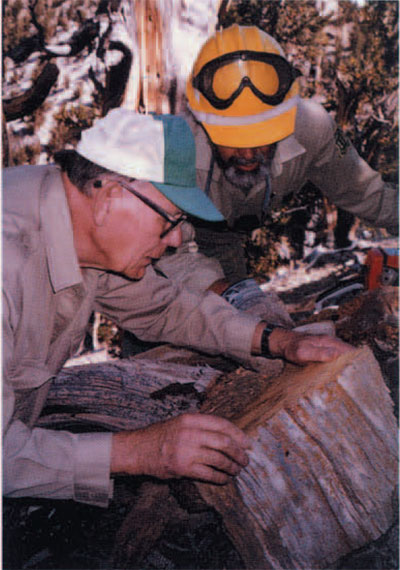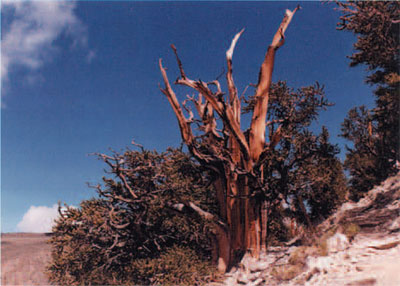
The advent of radiocarbon dating enabled scientists to put ancient organic remains into a far more reliable chronological framework than was once possible. But this technique only became precise when partnered with dendrochronology. The concept of dendrochronology-the science of dating past events by the comparative study of tree rings-is very old. In the 15the century, Leonardo da Vinci attempted to tell the age of trees by simple ring counting ad to track past seasonal variations (in terms of rainfall) by comparing the width of the rings.
The first extensive study of tree rings in the United States was begun in 1901 by A.E. Douglass, an astronomer who hoped to correlate sunspots and climatic changes. His study of long-lived trees, principally the Sequoia gigantea, led to the development of precise tree-ring dating, which, by cross-dating wood from living and dead bristlecone pines (Pinus aristata), was eventually extended by his students and their successors to ca. 7600 BC.
The development of radiocarbon dating by Willard Libby in the late 1940s introduced a new method of dating organic remains. However, inconsistencies were soon noted between established Egyptian chronologies and carbon-14 dates. It was later learned that one basic assumption of the radiocarbon method was invalid-the biosphere inventory of carbon 14 has not remained constant throughout time.
The idea of “correcting” radiocarbon dates stemmed from studies by Hl. de Vries, who detected variations in carbon 14 over the second half of the 2nd millennium AD, based on a comparison with precisely dated tree-ring samples. De Vrie’s lead was taken up by three labs: the Tree-Ring Laboratory at the University of Arizona, the La Jolla lab of the University of California at San Diego, and the Museum Applied Science Center for Archaeology (MASCA) at the University of Pennsylvania. The Ancient Bristlecone Pine Forest, a federal reserve in the White Mountains of California, served as the outdoor laboratory for the project. This was when Wesley Ferguson of the Tree-Ring Lab and I began our search for older and older woo.d Together we systematically combed the forest for preserved old wood.

Training the Eye to See Old Wood
To the casual observer, looking for old wood may seem to be a relatively simple process. Yet it requires considerable experience. Fore example, a tree that dies, say at age 4,000, will likely stand as a snag for perhaps a thousand years more. Finally, the snag will collapse onto the forest floor where it will rot very slowly because of its high resin content and because it is frozen and covered by snow up to 9 months of a year. Nevertheless, disintegration of the huge slabs does continue over many centuries: they separate into several pieces and slowly slide down the steep mountain slopes. Thus abraded fragments may turn up hundreds of meters below the elevations at which they grew and up to several kilometers from their area of origin.
The searcher, essentially a “forest floor gazer,” is looking for wood older than 9,000 years. An indicator of old wood may be its density: a piece with tight, narrow rings will contain a high percentage of resin and will not disintegrate readily. Another indicator may be location. A large, much eroded slab of wood with several rings lying between two very old trees, one upslope and one downslope from it, will likely prove to be older than either because it must have arrived at its location prior to the time the two living trees started growing. One such piece, discovered in 1978, proved to have almost 4500 rings, reaching back to 6240 BC.
The temporal ambiguity of the finds also explains why one can search for old wood over several summer seasons and find none, and then suddenly become lucky as I did in 1983 when I found a thin piece of wood with some 150 rings, which yielded a radiocarbon date of 7070 BC. The bristlecone pine tree-ring chronology was pushed rapidly back and today allows us to correct carbon-14 dates that reach into the end of the 8th millennium BC.

Dr. Henry N Michael is probably best known at the Museum, and to archaeologists around the world, for his ground-breaking collaborative research with Dr. Elizabeth K. Ralph on correction factors for radiocarbon dates. As the dendrochronologist in that partnership, he spent summer after summer in the Ancient Bristlecone Pine Forest collecting wood samples. Michael retired from Temple University in 1980, but has continued his research for the past 20 years while based in MASCA. At a luncheon in April 2000, he received the Director’s Award established to honor exceptional volunteer achievement.
Henry N. Michael
Senior Research Fellow, MASCA
